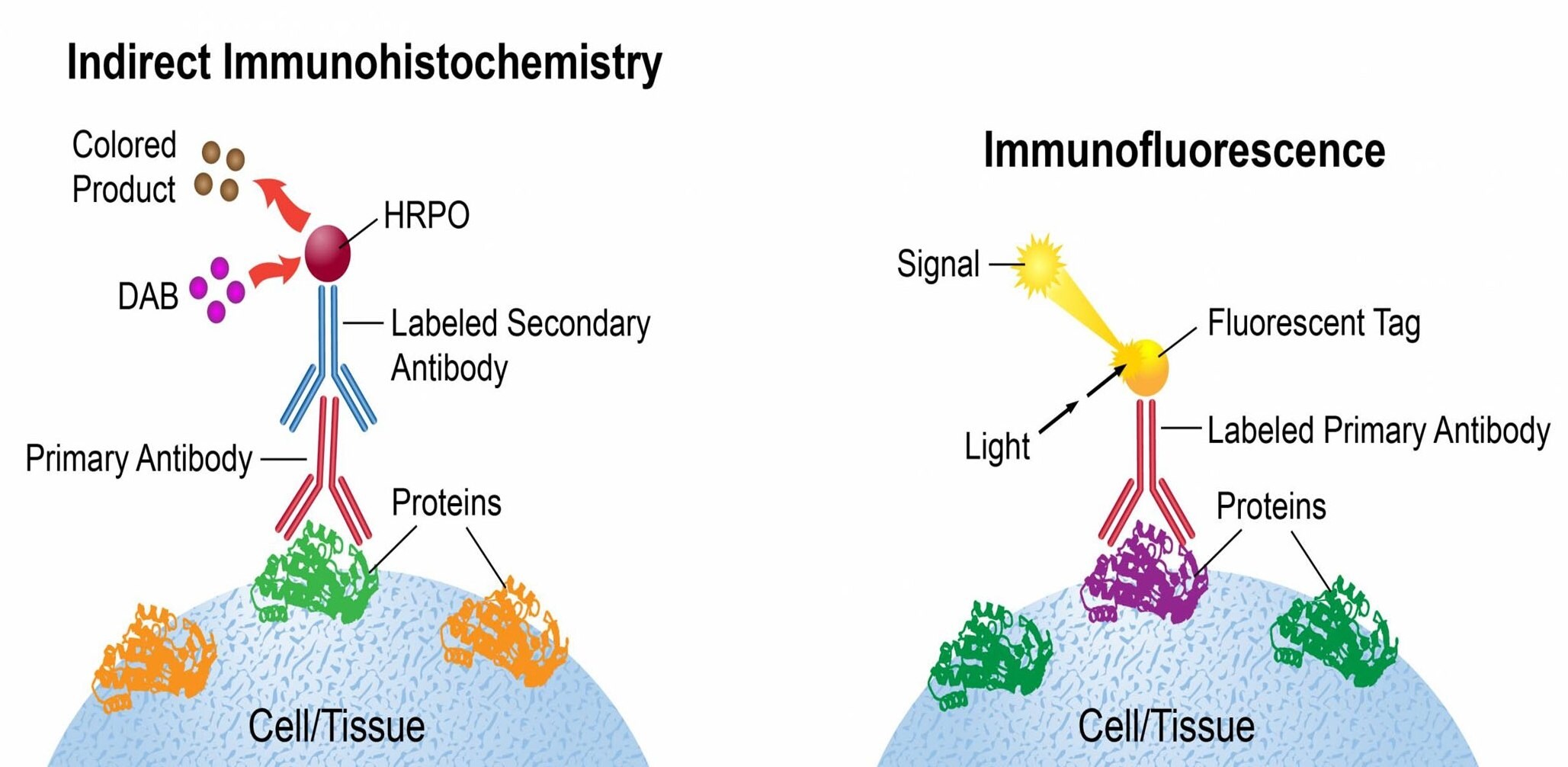Immunohistochemistry

Immunohistochemistry (IHC) and Immunofluorescence (IF) Detection Methods
Immunohistochemistry (IHC) is a biochemical method that uses antibodies that bind to specific antigens in a section of tissue. Similarly, immunocytochemistry (ICC) is suitable for identifying antigens in individual cell layers. IHC is commonly used to visualize proteins, carbohydrates, and lipids of interest in both healthy and diseased tissues, such as those found in cancerous tumors. Specific molecular markers are characteristic of cellular events such as proliferation or cell death (apoptosis). IHC is also widely used in basic research to understand the distribution and localization of biomarkers and differentially expressed proteins in different parts of biological tissue.
IHC Tissue Preparation, Antigen Retrieval and Pretreatment
Typically, tissues are fixed, embedded in paraffin, and sectioned for IHC analysis using a microtome. A significant step following the initial tissue preparation is the need for antigen retrieval. It is needed to break the protein cross-links formed during fixation and uncover hidden antigenic sites. Antigen retrieval and pretreatment conditions must be determined empirically, as the accessibility of the antigen epitope may vary significantly depending on numerous biological factors. For example, some antigens may require a more aggressive pretreatment in order to “unmask” their antibody-binding epitopes, while pretreatment may not be required at all for some antigens. Two common antigen retrieval pretreatment methods include Heat-Induced Epitope Retrieval (HIER) where a heat source is used in conjunction with buffers and enzymes (proteinase K). The second method, Proteolytic-Induced Epitope Retrieval (PIER) is another antigen retrieval method where various proteases may be used, such as proteinase k, trypsin, chymotrypsin or pepsin.
IHC Staining and Detection
Following tissue preparation and antigen retrieval pretreatment, visualizing the antibody-antigen interaction can be accomplished in a number of ways. One common method uses a primary antibody that is conjugated to an enzyme, such as horseradish peroxidase or alkaline phosphatase, that catalyzes a color-producing reaction. Alternatively, the immunofluorescence (IF) method uses an antibody that is tagged to a fluorophore, such as fluorescein, rhodamine, or Alexa Fluor. Another option is to use an unlabeled primary antibody, with indirect antigen detection by a labeled secondary antibody or more complex detection systems. In this case, the optimal titer of both the primary and secondary antibody should be determined for each assay.
Related Technical Articles
- Nitroblue Tetrazolium (NBT) is used with the alkaline phosphatase substrate 5-Bromo- 4-Chloro-3-Indolyl Phosphate (BCIP) in western blotting and immunohistological staining procedures. These substrate systems produce an insoluble NBT diformazan end product that is blue to purple in color and can be observed visually.
- Using antibodies in the lab from selection, antibody concentration and antibody storage
- ZooMAb® Antibodies Frequently Asked Questions
- Sigma® Antibody Bioguarantee – Complete peace of mind with your antibody purchase. Exemplary scientific support and a full credit or replacment product if you ar not complete satisfied
- In the midst of beeping lab timers, presentations and grant deadlines, it is easy to take for granted the quality of lab reagents.
- See All
Related Protocols
- Use this protocol to for the entire immunohistochemistry (IHC) procedure through staining and visualization of specific antigens in paraffin-embedded tissue sections.
- In the midst of beeping lab timers, presentations and grant deadlines, it is easy to take for granted the quality of lab reagents.
- One major rationale for investigating the subcellular location of a specific protein is that location is often tightly connected to function. For example, proteins locating to the nucleus are frequently implicated in gene regulation, proteins in mitochondria with energy production and Golgi-related proteins are often associated with protein modification and sorting.
- Prestige Antigens™ and the corresponding Prestige Polyclonals or Monoclonals are recommended to use according to the standard Prestige Antigen-blocking protocol
- We presents a protocol for the Prestige Antibody Immunohistochemistry Procedure. The Prestige Antibodies are subjected to a standardized test procedure using specially designed tissue microarray (TMA) slides.
- See All
To continue reading please sign in or create an account.
Don't Have An Account?